A Novel Approach for the Grid-Serving Implementation of Charging Infrastructures and Their Techno-Economic Integration in the Existing Power Grid
Abstract
1. Introduction
2. Introduction of a Novel Grid-Serving Energy Management Approach with Integrated Charging Infrastructures—Consideration of Structural, Economic and Regulatory Responsibilities
2.1. A Grid-Serving Cluster-Based and Incentive-Oriented Grid Operation Management System
2.2. Charging Processes and Responsibilities
2.3. The Current Structure of Electricity Billing in Germany
3. Development of the Hardware-in-the-Loop (HIL) Simulation Environment—Integration of a Grid-Serving Control System in the Current Operation and Billing System
3.1. The Two-Layer Simulation Model
- State-space based load flow layer:
- Socio-technical charging infrastructure layer:
- Hardware-in-the-loop real-time demonstrator:
3.2. Implementation of the Charging Infrastructure into the Power Grid and the ECS System
3.3. Design of the Charging Infrastructure Model
3.4. Description of the Dynamization of the Grid Charges Based on Physical Aging Effects
3.4.1. Thermal Aging
| Parameter | Description |
| A | Component specific constant |
| B | Component specific constant |
| T | Absolute temperature |
| T | Absolute temperature |
| Activating energy | |
| R | Gas constant |
| Hot spot temperature of the winding [°C] | |
| L(T) | Lifetime by occurring absolute temperature |
3.4.2. Economic Interpretation of the Load on the Power Grid
3.5. Incentive-Based Charging Control
4. Simulation and Results
5. Conclusions and Summary
Author Contributions
Funding
Data Availability Statement
Conflicts of Interest
References
- Sozialdemokratische Partei Deutschlands (SPD); BÜNDNIS 90/DIE GRÜNEN; Freie Demokratische Partei (FDP). Mehr Fortschritt Wagen—Bündnis für Freiheit, Gerechtigkeit und Nachhaltigkeit. Koalitionsvertrag. December 2021. Available online: https://www.spd.de/fileadmin/Dokumente/Koalitionsvertrag/Koalitionsvertrag_2021-2025.pdf (accessed on 30 December 2024).
- Xu, Q.; Huang, J.; Han, Y.; Yang, Y.; Luo, L. A Study on Electric Vehicles Participating in the Load Regulation of Urban Complexes. Energies 2020, 13, 2939. [Google Scholar] [CrossRef]
- Canizes, B.; Soares, J.; Costa, A.; Pinto, T.; Lezama, F.; Novais, P.; Vale, Z. Electric Vehicles’ User Charging Behaviour Simulator for a Smart City. Energies 2019, 12, 1470. [Google Scholar] [CrossRef]
- Canizes, B.; Soares, J.; Vale, Z.; Corchado, J.M. Optimal Distribution Grid Operation Using DLMP-Based Pricing for Electric Vehicle Charging Infrastructure in a Smart City. Energies 2019, 12, 686. [Google Scholar] [CrossRef]
- Monteiro, V.; Afonso, J.A.; Ferreira, J.C.; Afonso, J.L. Vehicle Electrification: New Challenges and Opportunities for Smart Grids. Energies 2019, 12, 118. [Google Scholar] [CrossRef]
- Trageser, M.; Vertgewall, C.M.; Offergeld, T.; Ulbig, A. Analysis of future electric mobility scenarios based on synthetic, georeferenced grid models. In Proceedings of the CIRED Porto Workshop 2022: E-Mobility and Power Distribution Systems, Hybrid Conference, Porto, Portugal, 2–3 June 2022; pp. 533–537. [Google Scholar] [CrossRef]
- Nacmanson, W.J.; Zhu, J.; Ochoa, L.F. Assessing the unmanaged EV hosting capacity of Australian rural and urban distribution networks. In Proceedings of the CIRED Porto Workshop 2022: E-Mobility and Power Distribution Systems, Hybrid Conference, Porto, Portugal, 2–3 June 2022; pp. 681–685. [Google Scholar] [CrossRef]
- Moses, R.J.U.P. Smart Grid Congestion Caused by Plug-in Electric Vehicle Charging. In Proceedings of the 2019 IEEE Texas Power and Energy Conference (TPEC), College Station, TX, USA, 7–8 February 2019; pp. 1–5. [Google Scholar] [CrossRef]
- Kreutmayr, S.; Finkel, M.; Niederle, S.; Witzmann, R.; Steinhart, C.J.; Gutzmann, C. Hosting capacity for electric vehicles in urban medium voltage grids with different building structure and charging strategies. In Proceedings of the 27th International Conference on Electricity Distribution (CIRED 2023), Rome, Italy, 12–15 June 2023; pp. 179–183. [Google Scholar] [CrossRef]
- Polat, Ö.; Eyüboğlu, O.H.; Gül, Ö. Monte Carlo simulation of electric vehicle loads respect to return home from work and impacts to the low voltage side of distribution network. Electr. Eng. 2021, 103, 439–445. [Google Scholar] [CrossRef]
- Strobel, L.; Schlund, J.; Pruckner, M. Joint analysis of regional and national power system impacts of electric vehicles—A case study for Germany on the county level in 2030. Appl. Energy 2022, 315, 118945. [Google Scholar] [CrossRef]
- Flath, C.M.; Gottwalt, S. Price-based load coordination revisited: Augmenting open-loop coordination approaches. Bus. Res. 2016, 9, 157–178. [Google Scholar] [CrossRef][Green Version]
- Zhu, J.; Nacmanson, W.J.; Ochoa, L.F. Understanding the effects of EV management and TOU tariffs on customers and distribution networks. In Proceedings of the 27th International Conference on Electricity Distribution (CIRED 2023), Rome, Italy, 12–15 June 2023; pp. 2465–2469. [Google Scholar] [CrossRef]
- Linnemann, M. Impuls #3: Auf Konfliktkurs: Dynamische Tarife vs. Dynamische Netzentgelte. Available online: https://itemsnet.de/blogging/auf-konfliktkursdynamische-tarife-vs-dynamische-netzentgelte/ (accessed on 30 December 2024).
- Vanselow, A.; Kalisch, L.; Krahl, S.; Moser, A. Simulation and comparison of the impact of different price tariffs on grid utilization. In Proceedings of the 27th International Conference on Electricity Distribution (CIRED 2023), Rome, Italy, 12–15 June 2023; pp. 3150–3155. [Google Scholar] [CrossRef]
- Zhou, Y.; Li, Z.; Wu, X. The Multiobjective Based Large-Scale Electric Vehicle Charging Behaviours Analysis. Complexity 2018, 2018, 1968435. [Google Scholar] [CrossRef]
- Tayarani, H.; Jahangir, H.; Nadafianshahamabadi, R.; Aliakbar Golkar, M.; Ahmadian, A.; Elkamel, A. Optimal Charging of Plug-In Electric Vehicle: Considering Travel Behavior Uncertainties and Battery Degradation. Appl. Sci. 2019, 9, 3420. [Google Scholar] [CrossRef]
- Srithapon, C.; Ghosh, P.; Siritaratiwat, A.; Chatthaworn, R. Optimization of Electric Vehicle Charging Scheduling in Urban Village Networks Considering Energy Arbitrage and Distribution Cost. Energies 2020, 13, 349. [Google Scholar] [CrossRef]
- Ahmadian, A.; Sedghi, M.; Mohammadi-ivatloo, B.; Elkamel, A.; Golkar, M.A.; Fowler, M. Cost-Benefit Analysis of V2G Implementation in Distribution Networks Considering PEVs Battery Degradation. IEEE Trans. Sustain. Energy 2018, 9, 961–970. [Google Scholar] [CrossRef]
- Burges, K.; Creutzburg, P.; Maas, N.; Nabe, C. Synthesebericht 2—Netzdienliche Flexibilitätsmechanismen. Synthesebericht. May 2022. Available online: https://www.bmwk.de/Redaktion/DE/Publikationen/Sinteg/synthesebericht-2-netzdienliche-flexibilitatsmechanismen.pdf?__blob=publicationFile&v=1 (accessed on 30 December 2024).
- Verband Sächsischer Wohnungsgenossenschaften e.V. Ladeinfrastruktur und Elektromobilität für die Wohnungswirtschaft. Dresden, Leitfaden, August 2019. Available online: https://www.vswg.de/uploads/tx_nbpubshop/Leitfaden_Ladeinfrastruktur_Elektromobilitaet_03.pdf (accessed on 30 December 2024).
- Bundesministerium für Wirtschaft und Energie. Rechtsgutachten zur Anwendbarkeit von § 3 Preisangabenverordnung (PAngV) auf Ladestrom für Elektromobile sowie zur Zulässigkeit und Vereinbarkeit Verschiedener am Markt Befindlicher Tarifmodelle für Ladestrom mit den Vorgaben der PAngV. 2018. Available online: https://www.bmwk.de/Redaktion/DE/Downloads/P-R/preisangabe-fuer-und-abrechnung-von-ladestrom-fuer-elektromobile-rechtsgutachten.pdf?__blob=publicationFile&v=1 (accessed on 30 December 2024).
- Bundesministerium der Justiz. Verordnung Über Technische Mindestanforderungen an den Sicheren und Interoperablen Aufbau und Betrieb von Öffentlich Zugänglichen Ladepunkten für Elektrisch Betriebene Fahrzeuge1 (Ladesäulenverordnung—LSV). 2016. Available online: https://www.gesetze-im-internet.de/lsv/BJNR045700016.html (accessed on 30 December 2024).
- Bundesnetzagentur. Monitoringbericht 2023. November 2023. Available online: https://www.bundeskartellamt.de/SharedDocs/Publikation/DE/Berichte/Energie-Monitoring-2023.pdf?__blob=publicationFile&v=4 (accessed on 30 December 2024).
- Bundesnetzagentur. 10 Thesen zum Thema‚ Flexibilität in Einem Zukünftigen Stromversorgungssystem. Available online: https://www.bundesnetzagentur.de/DE/Fachthemen/ElektrizitaetundGas/NEP/VerteilerNetz/Flexibilitaet/10Thesen.html?nn=1023742 (accessed on 30 December 2024).
- W. Zander u. a. dena-NETZFLEXSTUDIE Optimierter Einsatz von Speichern für Netz- und Marktanwendungen in der Stromversorgung. Berlin, Studie, March 2017. Available online: https://www.dena.de/fileadmin/dena/Dokumente/Pdf/9191_dena_Netzflexstudie.pdf (accessed on 30 December 2024).
- Bundesnetzagentur. Flexibilität im Stromversorgungssystem Bestandsaufnahme, Hemmnisse und Ansätze zur Verbesserten Erschließung von Flexibilität. Bonn, Diskussionspapier. April 2017. Available online: https://www.bundesnetzagentur.de/SharedDocs/Downloads/DE/Sachgebiete/Energie/Unternehmen_Institutionen/NetzentwicklungUndSmartGrid/BNetzA_Flexibilitaetspapier.pdf?__blob=publicationFile&v=1 (accessed on 30 December 2024).
- Bundesamt für Justiz. Gesetz über die Elektrizitäts- und Gasversorgung (Energiewirtschaftsgesetz—EnWG) Inhaltsübersicht. 2005. Available online: https://www.gesetze-im-internet.de/enwg_2005/ (accessed on 30 December 2024).
- Bundesnetzagentur. Beschluss—BK8-22/010-A. Bundesnetzagentur, Beschluss, November 2023. Available online: https://www.bundesnetzagentur.de/DE/Beschlusskammern/1_GZ/BK8-GZ/2022/2022_4-Steller/BK8-22-0010/BK8-22-0010-A_Festlegung_Download.pdf?__blob=publicationFile&v=5 (accessed on 30 December 2024).
- Özalay, B.; Schuster, H.; Kellermann, J.; Priebe, J.; Moser, A. Wirtschaftlicher Vorteil der Netzdienlichen Nutzung von Flexibilität in Verteilnetzen; Kurzstudie; E-Bridge: Tampa, FL, USA, 2019. [Google Scholar]
- Frontier Economics. Beitrag von Flexibilitäten im Verteilnetz zur Senkung der Redispatchkosten in Deutschland. Studie. July 2017. Available online: https://www.bdew.de/media/documents/20170809_Studie-Redispatchkosten.pdf (accessed on 30 December 2024).
- Agora Verkehrswende; Agora Energiewende; Regulatory und Assistance Project (RAP). Verteilnetzausbau für die Energiewende—Elektromobilität im Fokus. Studie. January 2020. Available online: https://www.agora-verkehrswende.de/fileadmin/Projekte/2019/EV-Grid/Agora-Verkehrswende_Agora-Energiewende_EV-Grid_WEB.pdf (accessed on 9 December 2024).
- Blenk, T.; Weindl, C. Characteristics and Advantages of a State-Space Orientated Calculation in Regenerative Energy Systems. In Proceedings of the 2022 International Conference on Diagnostics in Electrical Engineering (Diagnostika), Pilsen, Czech Republic, 6–8 September 2022; pp. 1–5. [Google Scholar] [CrossRef]
- Blenk, T.; Weindl, C. Fundamentals of State-Space Based Load Flow Calculation of Modern Energy Systems. Energies 2023, 16, 4872. [Google Scholar] [CrossRef]
- Blenk, T.; Weindl, C. Development of Methods for Sensitivity Analysis of Electrical Energy Networks and Systems within State Space. Energies 2024, 17, 4489. [Google Scholar] [CrossRef]
- Blenk, T.; Hertlein, T.A.; Weindl, C. Simulation of a Holistic Cluster-Based Incentive-Driven Load Flow Control in a Hardware-in-the-Loop Setup. In Proceedings of the 2023 IEEE PES Innovative Smart Grid Technologies Latin America (ISGT-LA), San Juan, PR, USA, 6–9 November 2023; pp. 435–439. [Google Scholar] [CrossRef]
- VDE; FNN. Netzintegration Elektromobilität; VDE and FNN: Berlin, Germany, 2019. [Google Scholar]
- Schlund, J. Electric Vehicle Charging Flexibility for Ancillary Services in the German Electrical Power System. Ph.D. Thesis, Friedrich-Alexander-Universität Erlangen-Nürnberg, Erlangen, Germany, 2021. [Google Scholar]
- Husarek, D.; Salapic, V.; Paulus, S.; Metzger, M.; Niessen, S. Modeling the Impact of Electric Vehicle Charging Infrastructure on Regional Energy Systems: Fields of Action for an Improved e-Mobility Integration. Energies 2021, 14, 7992. [Google Scholar] [CrossRef]
- Stiasny, J.; Zufferey, T.; Pareschi, G.; Toffanin, D.; Hug, G.; Boulouchos, K. Sensitivity analysis of electric vehicle impact on low-voltage distribution grids. Electr. Power Syst. Res. 2021, 191, 106696. [Google Scholar] [CrossRef]
- Nijenhuis, B.; Doumen, S.C.; Hönen, J.; Hoogsteen, G. Using mobility data and agent-based models to generate future E-mobility charging demand patterns. In Proceedings of the CIRED Porto Workshop 2022: E-Mobility and Power Distribution Systems, Hybrid Conference, Porto, Portugal, 2–3 June 2022; pp. 214–218. [Google Scholar] [CrossRef]
- Harbrecht, A.; McKenna, R.; Fischer, D.; Fichtner, W. Behavior-Oriented Modeling of Electric Vehicle Load Profiles: A Stochastic Simulation Model Considering Different Household Characteristics, Charging Decisions and Locations; Karlsruhe Institute of Technology (KIT): Karlsruhe, Germany, 2018. [Google Scholar] [CrossRef]
- Infas; DLR; IVT; Infas 360. Mobilität in Deutschland 2017. 2018. Available online: https://www.mobilitaet-in-deutschland.de/archive/publikationen2017.html (accessed on 30 December 2024).
- Ebner, M.; Fattler, S.; Ganz, K. Kurzstudie Elektromobilität: Modellierung für die Szenarienentwicklung des Netzentwicklungsplans; Forschungsstelle für Energiewirtschaft: München, Germany, 2019. [Google Scholar]
- Moser, A. Netzbetriebsmittel und Systemdienstleistungen im Hoch- und Höchstspannungsnetz; Zwischenbericht; Institut für Elektrische Anlagen und Netze, Digitalisierung und Energiewirtschaft: Aachen, Germany, 2021. [Google Scholar]
- DIN IEC 60076-7 VDE 0532-76-7:2023-05; Leistungstransformatoren, Teil 7: Leitfaden für die Belastung von Mineralölgefüllten Leistungstransformatoren. Deutsches Institut für Normung e. V., VDE Verlag GmbH: Berlin, Germany, 2023.
- Zapf, M.; Blenk, T.; Müller, A.-C.; Pengg, H.; Mladenovic, I.; Weindl, C. Lifetime Assessment of PILC Cables with Regard to Thermal Aging Based on a Medium Voltage Distribution Network Benchmark and Representative Load Scenarios in the Course of the Expansion of Distributed Energy Resources. Energies 2021, 14, 494. [Google Scholar] [CrossRef]
- Bottler, S.; Blenk, T.; Weindl, C. An approach for determining load-dependent monetary assessment factors for PILC and XLPE cables within a load flow simulation. In Proceedings of the 2022 Global Energy Conference (GEC), Batman, Turkey, 26–29 October 2022; pp. 58–64. [Google Scholar] [CrossRef]
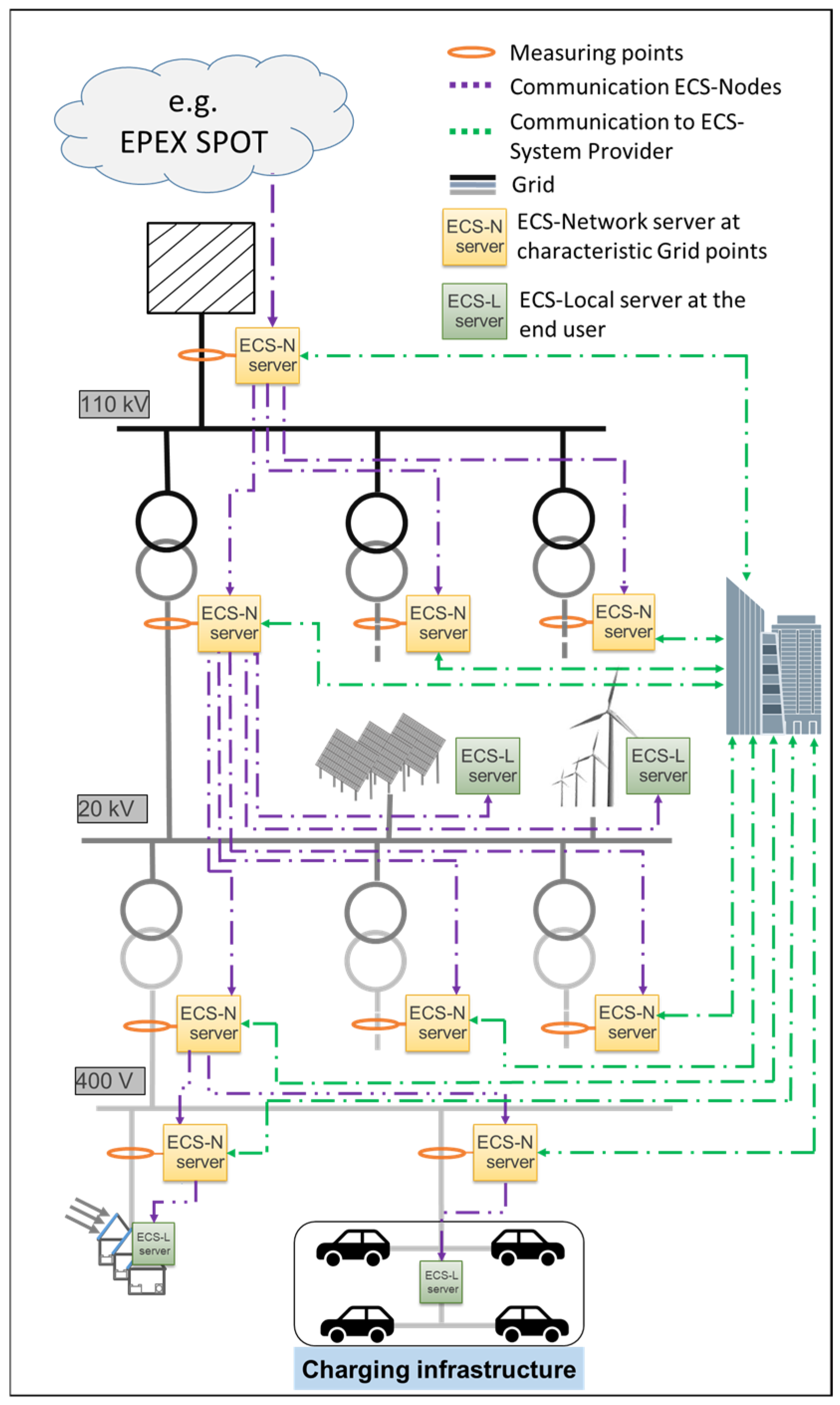
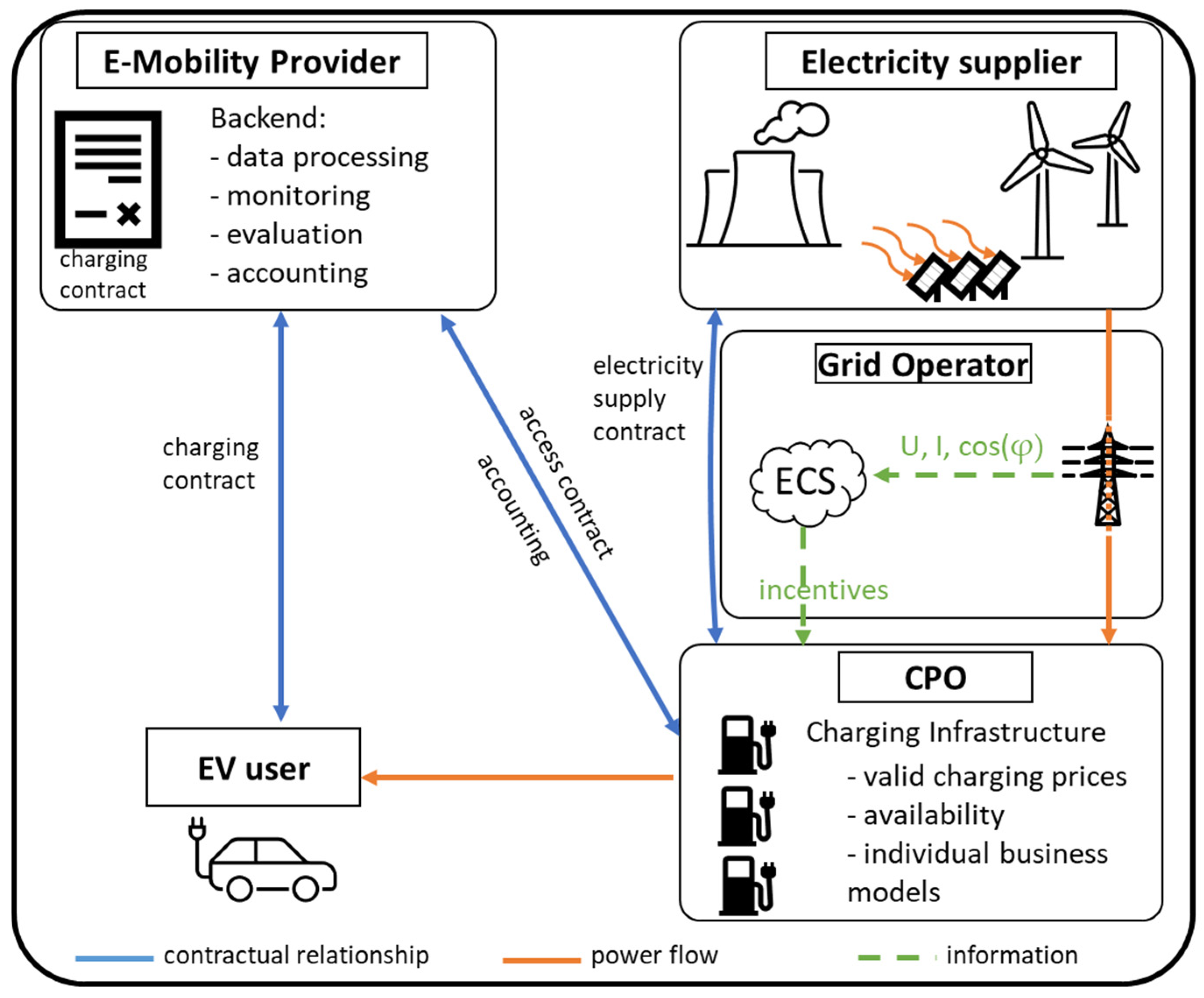
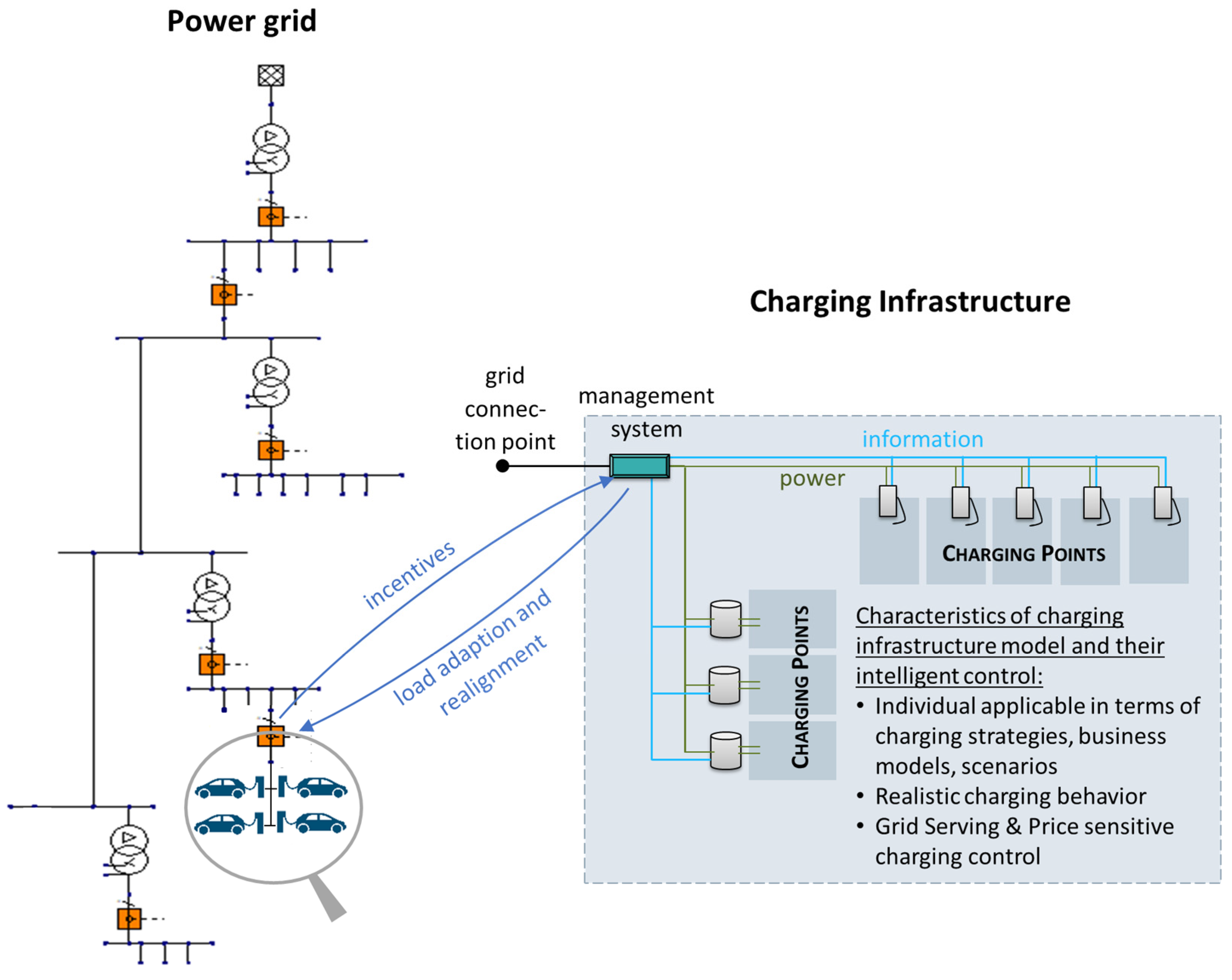

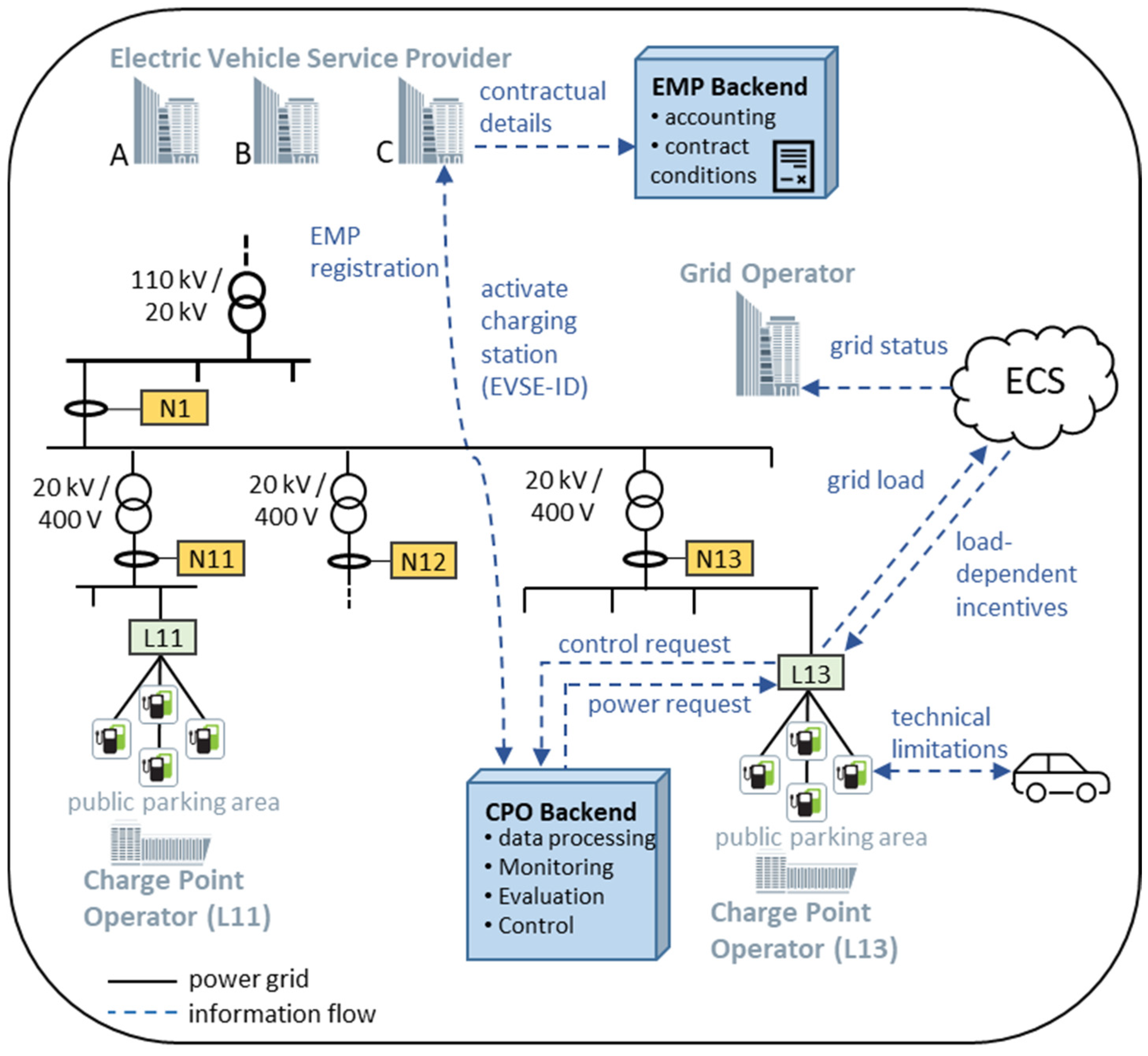

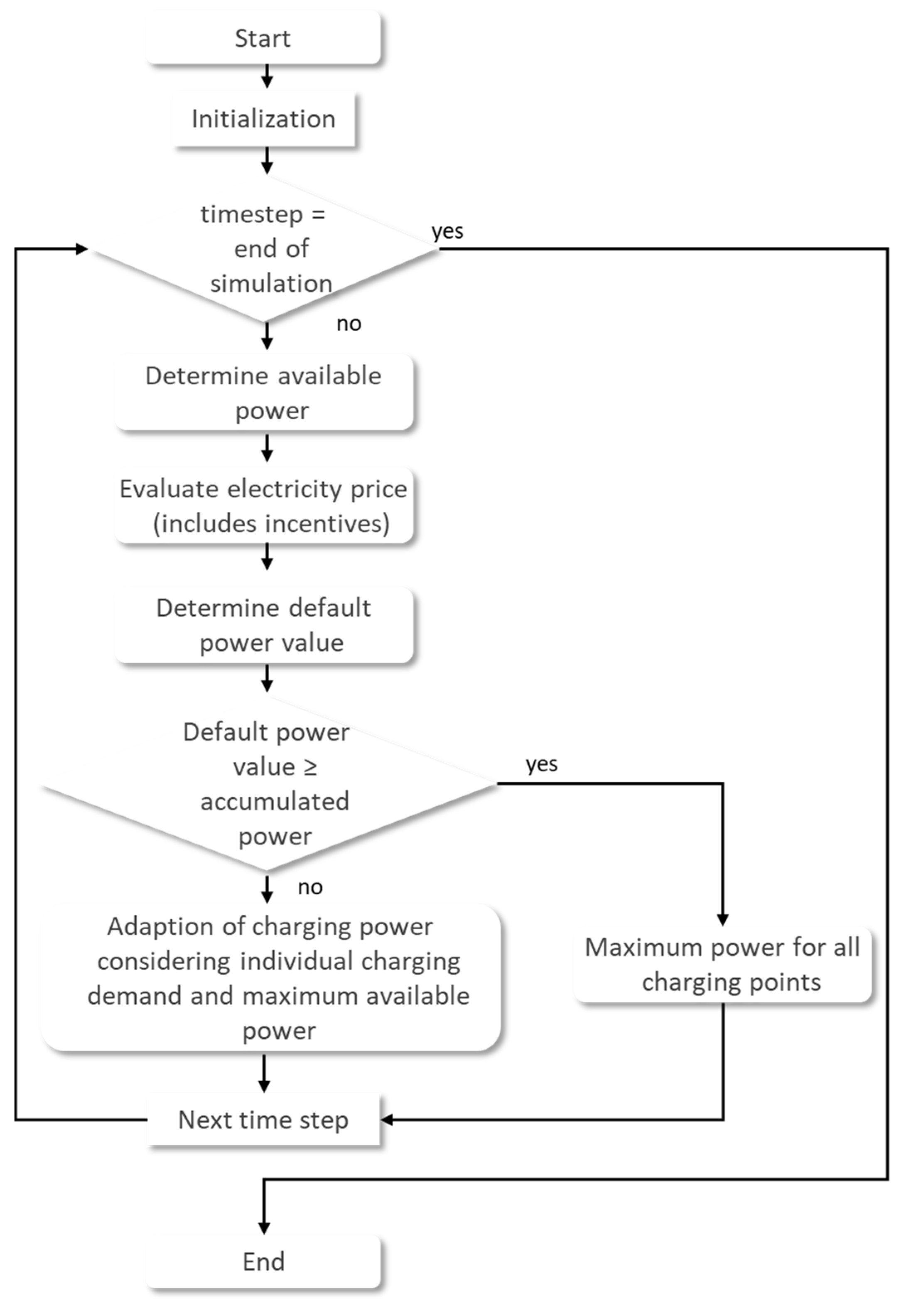

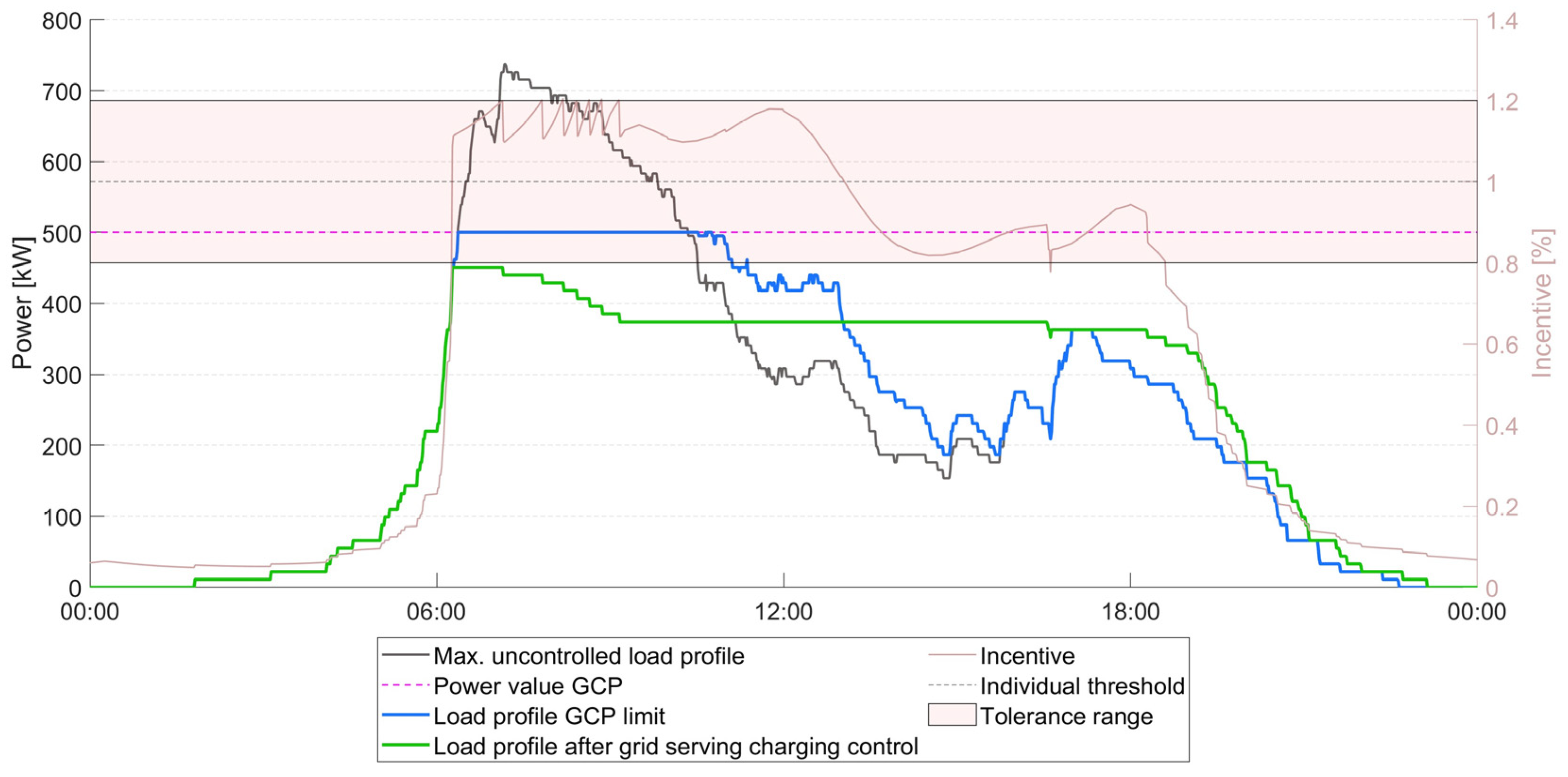
Disclaimer/Publisher’s Note: The statements, opinions and data contained in all publications are solely those of the individual author(s) and contributor(s) and not of MDPI and/or the editor(s). MDPI and/or the editor(s) disclaim responsibility for any injury to people or property resulting from any ideas, methods, instructions or products referred to in the content. |
© 2025 by the authors. Licensee MDPI, Basel, Switzerland. This article is an open access article distributed under the terms and conditions of the Creative Commons Attribution (CC BY) license (https://creativecommons.org/licenses/by/4.0/).
Share and Cite
Hertlein, T.A.; Mladenovic, I.; Weindl, C. A Novel Approach for the Grid-Serving Implementation of Charging Infrastructures and Their Techno-Economic Integration in the Existing Power Grid. Energies 2025, 18, 431. https://doi.org/10.3390/en18020431
Hertlein TA, Mladenovic I, Weindl C. A Novel Approach for the Grid-Serving Implementation of Charging Infrastructures and Their Techno-Economic Integration in the Existing Power Grid. Energies. 2025; 18(2):431. https://doi.org/10.3390/en18020431
Chicago/Turabian StyleHertlein, Timo Alexander, Ivana Mladenovic, and Christian Weindl. 2025. "A Novel Approach for the Grid-Serving Implementation of Charging Infrastructures and Their Techno-Economic Integration in the Existing Power Grid" Energies 18, no. 2: 431. https://doi.org/10.3390/en18020431
APA StyleHertlein, T. A., Mladenovic, I., & Weindl, C. (2025). A Novel Approach for the Grid-Serving Implementation of Charging Infrastructures and Their Techno-Economic Integration in the Existing Power Grid. Energies, 18(2), 431. https://doi.org/10.3390/en18020431




